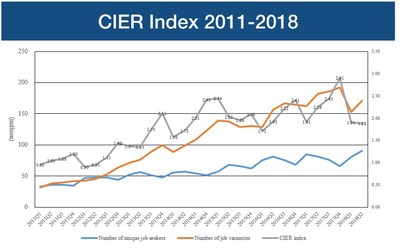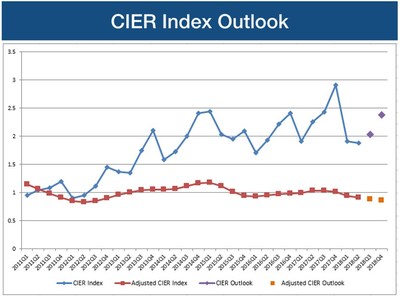TMCnet News
China Labor Market Index of Job Vacancies Continued to Fall in the Second Quarter of 2018BEIJING, July 19, 2018 /PRNewswire/ -- Zhaopin Limited ("Zhaopin" or the "Company"), a leading career platform in China focused on matching talent with skills and opportunities through their career lifecycle, and the China Institute for Employment Research ("CIER") at Renmin University of China released the CIER Employment Index Report for the second quarter of 2018. Since the Chinese New Year holiday came late this year, the busy season for job hopping in China continued over the second quarter. Though job openings experienced an increase over the previous quarter, the number of job seekers rose at a faster pace. As a result, the CIER index continued to drop to 1.88 in the second quarter of 2018, which means there were 1.88 job vacancies for each unique job seeker. The CIER index in the second quarter was lower than 1.91 in the first quarter of 2018, and also below the level of 2.26 in the second quarter of 2017. China's second-quarter 2018 labor market highlights:
CIER index falling with more job seekers Since the New Year Festival was in February this year, the traditional peak season for job hopping in China, and campus recruitment for college graduates continued to affect labor supply in the second quarter. While job openings grew 11.7% in the second quarter of 2018 over the first quarter, the number of job seekers also increased 13.3%, pushing the CIER index down to 1.88 in the second quarter of 2018, below 1.91 in the first quarter of 2018. Compared to the second quarter of 2017, the number of job openings declined 6.3%, while the number of job appliers increased 12.4%. As a result, the CIER index of 1.88 in the second quarter of 2018 was far below the level of 2.26 for the second quarter of 2017.
CIER index by sectors The gap between the best-performing sector and worst-performing sector expanded over the second quarter of 2018. The CIER index of the best performing sector was 12 times better than that of the worst performing sector, compared with a gap of 10 times in the first quarter of 2018. The intermediary services continued to outperform all other sectors as the best-performing sector in the second quarter of 2018 with a CIER index of 6.91. The internet/e-commerce sector fell to the third place with a CIER index of 4.76.
Most of the worst-performing sectors were still traditional manufacturing industries, including aerospace research and manufacturing, printing/packaging/papermaking, and energy/mineral/mining/smelting. The CIER indexes for all of these under-performing sectors remained below 1.
The trade/import and export sector experienced a drop in job openings in the second quarter of 2018, directly affected by the US-China trade war. The job demand in this sector fell 13% in the second quarter year-over-year. First-tier cities witnessed more severe decreases than smaller cities.
The intermediary service sector remained the best performing sector in the second quarter of 2018. The job demand in this sector increased by 22% compared to the second quarter of 2017. The demand mostly came from the third-tier cities and below.
The IT and Internet sector continued to slow down in the second quarter, as job demand dropped 6% compared to the second quarter of 2017. This was the first time that job openings in the sector decreased year-over-year since Zhaopin began to track the data in 2011. The job demand was also moving from first-tier cities to lower-tier cities. The IT and e-commerce sector fell to the third-best performing sector, as its CIER index plummeted to 4.76.
The funds/securities/investment sector significantly declined in the second quarter of 2018 with job demand decreasing by 34% year-over-year. First-tier cities suffered more severe decreases than lower-tier cities.
CIER index by occupations The best performing occupations in the second quarter of 2018 included mechanic/operator, sales, community/residency/housekeeping, and software/internet development/system integration.
The worst performing occupations in the second quarter of 2018 were PR/media, sales/business administration, property management, and manufacturing management/operation.
CIER index by regions and cities[1] In the second quarter of 2018, CIER indexes for Eastern China, Central China, and Western China continued to decline from the previous quarter, but still above 1, which means there were more job vacancies than job seekers in the quarter. Eastern China continued to enjoy the highest CIER index score of 1.46, followed by 1.33 for Central China and 1.11 for Western China. However, the labor market in Northeast China continued to deteriorate in the second quarter with CIER index dropping to 0.73.
The CIER index was higher in smaller cities than that in large cities in the second quarter of 2018. Third-tier cities had the highest CIER index score of 1.56, while the first-tier cities suffered with the lowest of 0.71.
CIER index by size of companies In the second quarter of 2018, large-sized companies retained the highest CIER index of 1.91, followed by 1.08 for micro-sized companies and 0.97 for medium-sized companies.
CIER index by type of companies The CIER index for most types of companies fell in the second quarter of 2018, except for wholly foreign-owned enterprises. Public companies remained the highest with CIER index of 1.02, followed by 0.98 for private companies.
Labor market outlook The labor market competition for job seekers is expected to ease and the CIER index is likely to rise in the third and fourth quarters of 2018. The trade war between China and the US will cast some uncertainties over the labor market.
Methodology and how to interpret the data Based on data from Zhaopin's online recruitment platform, the CIER index tracks the ratio changes between job vacancies and job seekers in a variety of industries and cities across the country, and identifies the overall trend in China's employment market. Jointly published by Zhaopin and the CIER at Renmin University of China every quarter, the CIER index has become a leading barometer of China's labor market and macro-economic environment. The CIER index score is calculated by dividing the number of job vacancies during a specified period by the number of unique job seekers during the same period. A CIER index score of more than 1 indicates that the labor market is booming, with more vacancies than job seekers. A CIER index score of less than 1 indicates that the labor market competition is intensifying, with more job seekers than available vacancies. For more information, please contact: Zhaopin Limited ICR Beijing
SOURCE Zhaopin Limited 
|
|||||||||||||||||||||||||||||||||||||||||||||||||||||||||||||||||||||||||||||||||||||||||||||||||||||||||||||||||||||||||||||||||||||||||||||||||||||||||||||||||||||||||||||||||||||||||||||||||||||||||||||||||||||||||||||||||||||||||||||||||||||||||||||||||||||||||||||||||||||||||


